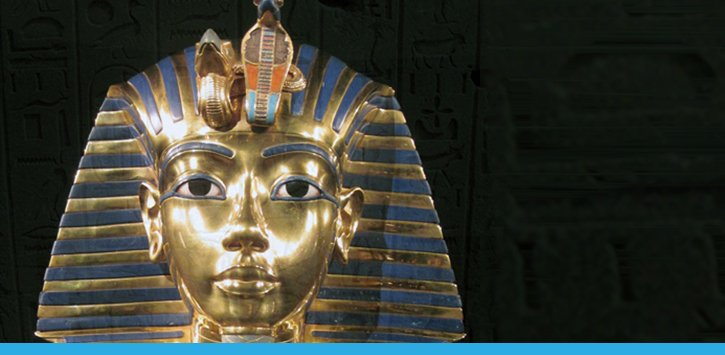This article was a collaboration between Yana Yeremenko and Carli Bermudez.
Have you ever wondered why King Tutankhamun was so popular in modern day culture? Mummies, legends, curses and treasures galore…King Tut’s tomb holds it all! Read on in this article to learn more about the finding of his tomb, the mummified body, the life, fascinating facts and treasures this once famous king had in 1332 B.C.E.
The Life, the Death, and the Tomb
On November 4, 1922, a boy accidentally stumbled on a stone that turned out to be the top of a flight of steps cut into the bedrock. One month later, Howard Carter entered the pharaoh’s tomb and discovered the sarcophagus of King Tut! King Tut ruled Egypt as pharaoh for 10 years until his death at age 19, around 1324 B.C. Although his rule was notable for reversing the tumultuous religious reforms of his father, Pharaoh Akhenaten, Tutankhamun’s legacy was largely negated by his successors. King Tut was only 9 years old when he was crowned pharaoh! Can you believe that? Tut’s name wasn’t always Tutankhamun. His original name, Tutankhaten, means “Living Image of Aten”, while Tutankhamun means “Living Image of Amun”
Queen Ankhesenamun married King Tut at the age of 13. King Tut was even younger at just a few years shy of ten. The couple was married in 1334 BC.The last coffin, made of solid gold, contained the mummified body of King Tut. Among the riches found in the tomb–golden shrines, jewelry, statues, a chariot, weapons, clothing–the perfectly preserved mummy was the most valuable, as it was the first one ever to be discovered. King Tut ruled Egypt as pharaoh for 10 years until his death at age 19, around 1324 B.C. Although his rule was notable for reversing the tumultuous religious reforms of his father, Pharaoh Akhenaten, Tutankhamun’s legacy was largely negated by his successors. In 2014, producers of a BBC television documentary postulated that Tut died in a chariot crash that broke his legs and pelvis, and resulted in an infection and perhaps death by blood poisoning.
Mummies ‘n’ More
When important people like Pharaohs died, Egyptians would have a kind of ritual for them. They were expensive, and poor families could not afford it for their members. They would do this process to preserve the bodies and make mummies. They kept these mummies in chambers called tombs. The 70 day mummification process went like this:
1. The body was washed
2. A cut was made on the left side of the abdomen and the internal organs – intestines, liver, lungs, stomach, were removed. The heart, which the Ancient Egyptians believed to be the center of emotion and intelligence, was left in the body for use in the next life.
3. A hooked instrument was used to remove the brain through the nose. The brain was not considered to be important and was thrown away.
4. The body and the internal organs were packed with natron salt for forty days to remove all moisture.
Th5. The dried organs were wrapped in linen and placed in canopic jars. The lid of each jar was shaped to represent one of Horus’ four sons.
6. The body was cleaned and the dried skin rubbed with oil.
7. The body was packed with sawdust and rags and the open cuts sealed with wax
8. The body was wrapped in linen bandages. About 20 layers were used and this took 15 to 20 days.
9. A death mask was placed over the bandages
10. The bandaged body was placed in a shroud (a large sheet of cloth) which was secured with linen strips.
11. The body was then placed in a decorated mummy case or coffin.
The Egyptians did this, because they believed that there was an ‘Afterlife.’ They would put scrolls, treasure, and more in the tomb to help them get through any tests that may come up on the way to the ‘Afterlife.’ The Egyptians also had several different gods. Each a different aspect in nature, like the Sun god Ra. Most Egyptians even believed that the Pharaoh got his power from the gods, and that he was one himself!
Fun Facts About King Tut!
- Among the world’s most famous curses is the “Curse of the Pharaoh,” also known as King Tut’s Curse. Ever since King Tutankhamun’s tomb was discovered in Egypt’s Valley of the Kings, stories circulated that those who dared violate the boy king’s final resting place faced a terrible curse.
- A new pharaoh took over after his death, and to preserve his power, he erased all information about King Tut’s family and him from history. King Tutankhamen was largely erased from history until his tomb was discovered in the 1900s. Using DNA, and CT scans, they found out the mummy was King Tut. His tomb and mummy are still being studied using high-tech tools. If you want to read more about that, go to this website; King Tut | National Geographic Society
- King Tut was the last ruler of his Dynasty.
- King Tut does not have his own Pyramid.
- He married his half-sister. They had the same father, but different mothers.
- King Tut loved ostrich hunting.
Where in the World is… King Tut Buried?
Map showing the city Luxor, where King Tutankhamun was buried in the ‘Valley of the Kings.’
Thank you for reading our article on the discovery of King Tutankhamen! Do you want to learn more? Check out the sources below!

